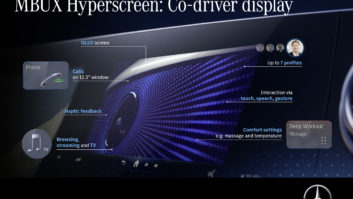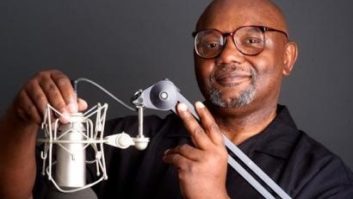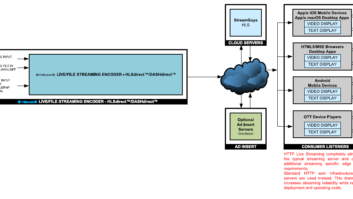(click thumbnail)Jorge Silva, working on the NBC daytime show “Martha,” mixes broadcast audio on the Studer Vista 8.As the transmission end of the digital transition nears completion, stations are turning their attention more to the studio and control room side of their facilities. And audio is definitely part of the mix.
“This January has been the busiest start we have ever seen to a new year,” said Andrew Wild, vice president of marketing for Euphonix in Palo Alto, Calif. “The pressure is on for facilities to upgrade to HD, which includes upgrading the audio console to handle larger numbers of channels encountered with surround operations and to go fully digital.”
People are upgrading for other reasons as well, said Phil Owens, a sales engineer with Wheatstone in New Bern, N.C.
“The biggest [reason] remains the replacement of old outdated equipment that represents a liability to the station. Others are involved with creating automated news operation,” he said.
Wheatstone products include the D-10, D-12, D-5.1 digital consoles. Owens said that the company’s TCP/IP interface capability has become an increasingly important feature in new installations involving automation.
For the mobile production truck people, upgrading also means shifting from older digital gear to the latest generation of digital audio technology, said Kevin Emmott, marketing coordinator for Calrec in West Yorkshire, U.K.
“Many of our customers, particularly truck operators who regularly mix for live sports and entertainment are upgrading their existing consoles to Bluefin,” he said. Bluefin is Calrec’s HDSP — high density signal processing — technology.
“Conventional DSP systems are limited by the number of signals that have to pass from one DSP card to another, which have to fight for space on the backplane along with input and output signals,” Emmott said. “As this space is limited by backplane speed and the physical space for tracking, the size of the system is constrained. Bluefin HSDP overcomes this by condensing all the DSP onto one card. Bluefin also provides 480 fully equipped mono equivalent channels on the Alpha and 320 fully equipped mono equivalent channels on the Sigma console, on just one DSP card. Bluefin will be introduced on the Zeta console at NAB2007.”
Bluefin also allows for substantially more delay and other processes that were impossible with a traditional DSP core, Emmott added.
A CLEAR FUTURE
With the upgrade to digital, surround sound capabilities are increasingly becoming part of the package. Yet its importance can’t be discounted, said Claude Hill, sales director for La Vergne, Tenn.-based Harrison Consoles, maker of the Trion console.
“Very few customers today will consider an audio console that does not have 5.1 or is not 5.1 capable because the future is clear for all terrestrial broadcasting, cable and satellite content delivery,” he said.
Considering that the lifespan of an audio console could be 10 years or more, Clayton Blick, national sales manager at Studer USA in Northridge, Calif., said, “Customers don’t want to box themselves into a corner and buy a console that is not surround-capable.” Even with a 5.1 console, “it doesn’t mean that they have to broadcast 5.1 today. Moving to 5.1 is daunting for some people. They can start by simply passing 5.1 sources in and out, like network or taped feeds.”
For productions, he said, they can “maybe synthesize something in the rear speakers. Later they can explore 5.1 mic techniques.”
Hill said price, too, is having an effect, in some cases.
“The availability of digital systems at costs lower than analog has motivated many customers to proceed with upgrades and new facilities,” he said.
NEW MARKETS, NEW DEMANDS
Logitek Electronic Systems, known for its radio boards and audio metering systems, has entered the TV market with its introduction of the Artisan digital console.
Frank Grundstein, director of sales for Logitek in Houston, said Logitek’s Artisan series router-based console “is designed to have the features that medium to small market stations are looking for at a price that they can afford.”
As more stations upgrade, they need to look for a console capable of handling large numbers of channels, in a scaleable way so that the console can be upgraded as requirements change, said Wild at Euphonix.
“The larger the station, the more ambitious the shows. So the larger stations want to be able to handle a wider variety of shows with more channels,” Wild said. “The smaller stations still need all the main features of a broadcast console but usually want a smaller footprint, lower cost and fewer channels. That is why Euphonix offers two systems, System 5-B for larger facilities and Max Air for the smaller stations where space and cost are at a premium.”
Studer makes the Vista 5 with 32 faders and, with layers, the equivalent 242 mono or stereo positions, and also the Vista 8 with a redundant operating system, larger meters, and up to 72 faders with 482 positions, Blick said.
“We can cover the whole range with those two,” he said.
Ease of use and a clear operator interface would top many customers’ list of requirements. For those used to mixing on analog boards, software-based digital consoles can at first appear intimidating, with surround mixing adding to the anxiety. But manufacturers have devised various strategies in console design and user interface to make that transition easier.
Depending on the design philosophy, consoles can use inline controls or a central control panel, but in either case, allow for quick and easy adjustment of the various parameters. Layers can be kept at a minimum, or if they are used, the easy means for control is provided.
Take SSL for example. Niall Feldman, director of product marketing for the Oxford, England-based company, said that a console should be easy to operate in surround, with the console taking care of the complexity of the mixing process while letting the operator concentrate on balancing the show’s audio.
“The C-series consoles deal with this through advanced features such as surround channels with multichannel EQ, dynamics and panning that present the operator with a simple, single-channel approach to a surround source,” Feldman said. “Also powerful and adaptable monitoring that allows complex insert facilities for surround encode/decode systems mean that what the operator hears, is what the domestic listener hears.”
Redundancy is another big issue for consoles used for live production. Wild said that Euphonix provides 100 percent secure DSP/router capabilities on its broadcast consoles.
Studer can provide redundant power supplies, a redundant DSP, and a redundant operating system with mirrored data for its Vista 8 console, according to Blick.
Emmott from Calrec suggests that a customer ask for an unrehearsed demonstration of redundancy and hot-swapping.
“And while you’re at it, turn off the power at random, and see how well and how quickly the board gets back to where it was,” he said.
Grundstein from Logitek lists more features that customers are demanding: The ability to pass mono, stereo and 5.1; frame delay at the fader; lots of mix minus busses and the ability to reconfigure mix minus easily at the console; easily implemented IFB; lots of surface “snapshots;” blend capability at the fader for balancing field report audio; the ability to talk to various routers and storage devices; easily configurable aux busses and submasters; plenty of metering; and the ability to add capacity at a reasonable cost and without having to take the system down.
Blick from Studer said that supporting a variety of input and output formats—analog, AES/EBU, SDI-embedded audio, MADI, and Dolby E—was important given the wide variety of devices that must be interconnected to the console.
Another factor is networking, between the console mainframe and one or more control surfaces, and networking among different mainframes, Emmott said.
“Ask whether networking is available and whether it has the capacity for growth,” he said. “Networking can save significant costs on installation, especially if you have or may have multiple rooms and studio floors. It enables future development to be cheaper and more flexible.”
In choosing the digital audio mixing system that’s just right for any given facility, it’s very important to get in front of the console to see how it feels from an ergonomic point of view, Wild said. Questions to ask are: how easy is it to operate? How fast can it be installed? Are there other users doing similar work who are happy with this same console?
“It’s essential to talk with other users,” Wild said. “Also ask, how good is your local support? How close is the manufacturer to your facility? Has the console proved itself over a period of time?”













